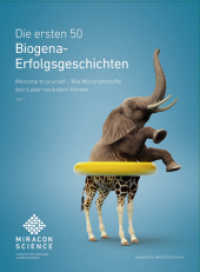Full Description
This practical guide gives valuable insights for integrating advanced technologies in healthcare, empowering researchers to effectively navigate and implement federated systems to enhance patient care.
Federated Intelligent Systems for Healthcare: A Practical Guide explores the integration of federated learning and intelligent systems within the healthcare domain. This volume provides an in-depth understanding of how federated systems enhance healthcare practices, detailing their principles, technologies, challenges, and opportunities. Additionally, this book addresses secure and privacy-preserving sharing of medical data, applications of artificial intelligence and machine learning in healthcare, and ethical considerations surrounding the adoption of these advanced technologies. With a focus on practical implementation and real-world use cases, Federated Intelligent Systems for Healthcare: A Practical Guide equips healthcare professionals, researchers, and technology experts with the knowledge needed to navigate the complexities of federated intelligent systems in healthcare and harness their potential to transform patient care and medical advancements.
Readers will find the book:
Provides cutting-edge research from industry experts to unlock the future of healthcare with innovative insights that embrace federated intelligence and shape the future;
Presents novel technologies and conceptual and visionary-based scenarios;
Discusses real-world case studies and implementations that illustrate how federated intelligence is practically applied across various healthcare scenarios, from personalized diagnostics to population-level insights;
Stands as a pioneer in the exploration of federated intelligent systems in healthcare.
Audience
Data scientists, IT, healthcare and business professionals working towards innovations in the healthcare sector. The book will be especially helpful to students and educators.
Contents
Preface xiii
1 Introduction to Federated Intelligent Systems in Healthcare 1
Naseem Ahmad
1.1 Introduction 2
1.2 Evolution and Principles of Federated Learning in Healthcare 4
1.3 Applications of Federated Learning in Healthcare 6
1.4 Challenges and Limitations of Federated Learning in Healthcare 11
1.5 Future Directions and Innovations in Federated Healthcare Systems 15
1.6 Conclusion 20
References 21
2 Federated Autonomous Deep Learning for Distributed Healthcare System 25
Rakesh Mohan Pujahari, Rijwan Khan and Satya Prakash Yadav
2.1 Introduction 26
2.2 Background 27
2.3 Use of Federated Learning 28
2.4 Smart and Efficient Healthcare Systems: Various Types of Federated Learning 32
2.5 Healthcare Integrated Learning in IoMT Apps 33
2.6 Federated Learning Based on Federated Mechanisms and Difficulties in Healthcare Applications 35
2.6.1 Data Security and Breach 35
2.6.2 Heterogeneity of Data 38
2.6.3 Compliance Regulatory Mechanism 39
2.6.4 Data Governance 39
2.6.5 Process of Communication Overhead 40
2.6.6 Model Selection and Aggregation 42
2.6.7 Annotation and Labeling of Data 43
2.6.8 Model Drift 45
2.6.9 Resource Constraints 46
2.6.10 Bias and Fairness 47
2.6.11 Interoperability 48
2.6.12 Engagement and Incentives Related to Patients 49
2.6.13 Scalability 50
2.6.14 Considerations Based on Ethics 51
2.7 Healthcare Issues and Their Solutions Related to Federated Learning 52
2.8 Directions for Future Use of Federated Learning in the Medical System 54
2.9 Conclusion 55
References 56
3 Intelligent Fusion: Federated Learning and Blockchain in Sustainable Healthcare 5.0 61
Pankaj Kumar Jadwal and Hemant Kumar Saini
3.1 Introduction 62
3.2 Distributed Data in Healthcare 64
3.2.1 FL Algorithms 64
3.2.2 Blockchain Approaches 66
3.2.3 Fusion of BC and FL 66
3.2.4 Framework/Architecture 67
3.3 IoHT Applications and Their Wideband Challenges 71
3.3.1 In Medical Units 72
3.3.2 Remote Healthcare from Homes 72
3.3.3 Patient-Generated Data 73
3.4 Tools 73
3.5 Case Studies 74
3.6 Conclusion 76
Future Directions 76
References 77
4 Foundations of Federated Intelligent Systems in Healthcare 81
Rachna Behl, Indu Kashyap and Neha Garg
4.1 Introduction 82
4.2 Core Concepts of Federated Learning 83
4.2.1 Federated Learning Training Process 83
4.2.2 Key Principles of Federated Learning 85
4.2.3 Comparing Traditional and Federated Learning: Data Management, Privacy, Scalability, and Performance 86
4.2.4 Applications of Federated Learning 88
4.3 FL in Healthcare 88
4.3.1 Need of FL in Healthcare 88
4.3.2 Types of FL for Healthcare 89
4.3.3 Role of Federated Learning in Healthcare 90
4.4 Federated Learning in Healthcare: Case Studies 92
4.5 Challenges and Ethical Consideration 94
4.6 Conclusion and Future Scope 96
References 97
5 Integrating Edge Devices and Internet of Medical Things in Modern Healthcare 101
Manoj Kumar Patra and Nandita Bhanja Chaudhuri
5.1 Introduction 102
5.1.1 Importance and Impact on Modern Healthcare 102
5.1.2 Historical Context and Evolution of Medical Technology 103
5.2 Edge Devices in Healthcare 103
5.2.1 Functionalities of Edge Devices in Patient Monitoring 104
5.2.2 Edge Device Applications in Healthcare 104
5.3 Internet of Medical Things (IoMT) 105
5.3.1 IoMT for Enhanced Healthcare Delivery 106
5.3.2 Integration of IoMT with Existing Healthcare Systems 107
5.4 Benefits of Integrating Edge Devices and IoMT 108
5.4.1 Accuracy and Efficiency in Diagnostics and Treatment 108
5.4.2 Reduction in Latency and Faster Decision-Making 109
5.4.3 Cost-Effectiveness and Resource Optimization in Healthcare 109
5.5 Key Technologies Enabling Integration 110
5.5.1 Edge Computing 110
5.5.2 Data Analytics and Machine Learning for Healthcare Insights 111
5.5.3 Communication Protocols and Standards 111
5.5.4 Cloud Computing for Data Storage and Processing 112
5.6 Applications and Use Cases of Edge Devices and IoMT 113
5.6.1 Remote Patient Monitoring and Telemedicine 113
5.6.2 Chronic Disease Management 114
5.6.3 Emergency Response Systems and Critical Care 114
5.6.4 Smart Hospitals and Healthcare Facilities 115
5.7 Challenges and Considerations 116
5.7.1 Data Privacy and Security Concerns in IoMT and Edge Devices 116
5.7.2 Interoperability and Integration with Existing Healthcare Infrastructure 117
5.7.3 Scalability and Network Reliability 117
5.7.4 Regulatory and Compliance Issues 118
5.8 Future Trends and Innovations 119
5.8.1 Advances in Edge Computing Technologies and Their Potential Impact 119
5.8.2 Emerging Applications of IoMT in Personalized Medicine 120
5.8.3 Integration with Artificial Intelligence and Predictive Analytics 121
5.8.4 Potential for Blockchain in Securing IoMT Data 121
5.9 Conclusion 122
References 123
6 Cloud Infrastructure and Federated Learning 127
Kanishka Gupta, Amit Aylani, Prakash Parmar and Deepak Hajoary
6.1 Foundations of the Future: Cloud Infrastructure Meets Federated Learning 128
6.1.1 Types of Cloud Deployments 129
6.1.2 Services of Cloud Computing 130
6.2 What is Federated Learning? 133
6.2.1 Mechanics of Federated Learning 134
6.3 The Essence of Collaboration: Federated Learning Unveiled 136
6.3.1 Concept and Working of Federated Learning 136
6.3.2 Types of Federated Learning 138
6.4 Harmonizing Cloud and Edge: The Integration Paradigm 140
6.4.1 Leveraging Cloud Resources for Federated Learning 140
6.4.2 Deployment of Federated Learning Models on the Cloud 145
6.4.3 How Federated Learning Models are Deployed on the Cloud 146
6.5 Real-World Applications of Federated Learning 149
6.6 Conclusion and Future Directions 150
References 151
7 Machine Learning and Artificial Intelligence Fundamentals for Federated Systems 153
N. Vinaya Kumari, G. S. Pradeep Ghantasala, Pellakuri Vidyullatha and Rajesh Sharma R.
7.1 Overview of Machine Learning and Artificial Intelligence 154
7.1.1 Definition of Machine Learning 154
7.1.2 Definition of Artificial Intelligence 154
7.1.3 Importance of ML and AI in Modern Technology 155
7.2 Key Concepts in Machine Learning 155
7.2.1 Data and Features 155
7.2.2 Algorithms and Models 156
7.2.3 Training and Testing 157
7.3 Fundamentals of Artificial Intelligence 157
7.3.1 Neural Networks 157
7.3.2 Deep Learning 157
7.3.3 Natural Language Processing (NLP) 158
7.3.4 Reinforcement Learning 158
7.4 Federated Learning 158
7.4.1 Definition and Importance 158
7.4.2 Architecture of Federated Learning Systems 159
7.4.3 Applications of Federated Learning 159
7.5 Challenges in Federated Learning 161
7.5.1 Data Heterogeneity 161
7.5.2 Communication Efficiency 161
7.5.3 Privacy and Security 161
7.5.4 System and Computational Constraints 162
7.6 Key Algorithms for Federated Learning 162
7.7 Model Aggregation and Optimization 164
7.7.1 Aggregation Techniques 164
7.7.2 Optimization Algorithms 164
7.8 Conclusion 166
References 166
8 Reconstructing Healthcare Foundations: Building Blocks of Federated Systems in Medical Technology 171
Blessing Takawira and David Pooe
Introduction 172
Historical Context and Evolution of Healthcare Systems 174
Fundamental Concepts of Federated Healthcare Systems 176
Technological Foundations 179
Building Blocks of Federated Healthcare Systems 180
Communication Protocols 181
Edge Devices and IoMT Integration 183
Privacy and Security Considerations 185
Systematic Literature Review Process 187
Solutions and Recommendations 188
Future Research Directions 191
Conclusion 192
References 193
Key Terms and Definitions 199
9 Federated Learning in Brain Tumor Segmentation in Medical Imaging 201
Jyoti Kataria and Supriya P. Panda
9.1 Introduction to Federated AI in Medical Imaging 202
9.1.1 Federated Learning Key Concepts 203
9.1.2 Overview of AI Techniques and Key Architectures Used in Segmentation 205
9.1.3 Importance of Accurate Segmentation in Diagnosis and Treatment 206
9.2 Traditional Segmentation Methods 206
9.2.1 Overview of Traditional Techniques 207
9.2.2 Advantages of Traditional Methods 209
9.2.3 Limitations of Traditional Methods 209
9.3 AI-Based Segmentation Methods 210
9.3.1 Convolutional Neural Networks (CNNs) 210
9.3.1.1 The Benefits of CNN-Based Segmentation 211
9.3.2 U-Net and its Variants 212
9.3.2.1 U-Net's Advantages for Brain Tumor Segmentation 213
9.3.3 ResNet 50 214
9.3.3.1 ResNet's Advantages for Brain Tumor Segmentation 215
9.3.4 Benefits of Federated Learning in Brain Tumor Segmentation 216
9.3.5 Comparison of Brain Tumor Segmentation Methods 218
9.3.6 Case Studies by Different Institutions 221
9.4 Advantages and Challenges of AI-Based Methods 223
9.4.1 Advantages 223
9.4.2 Challenges 224
9.5 Federated Learning Workflow for Brain Tumor Segmentation 225
9.6 Notable Projects and Research 227
9.6.1 Federated Tumor Segmentation (FeTS) Initiative 227
9.6.2 Federated Learning for Healthcare (FL4HC) 227
9.6.3 AI for Health by NVIDIA Clara's 227
9.6.4 The Role of FL in BraTS 228
9.6.5 Collaborative Research with Hospitals and Universities 228
9.6.6 OpenFL by Intel 228
9.6.7 Google Health's Federated Learning Projects 228
9.7 Conclusion 229
9.8 Future Scope 229
References 230
10 Disease Prediction and Early Diagnosis Using Federated Models 233
Vibha Tiwari, B. K. Mishra, Nitya Hari Das, Balwinder Singh and Harmandeep Kaur
10.1 Introduction 234
10.1.1 FL in Healthcare 234
10.2 Related Works 236
10.2.1 Machine Learning (Deep Learning) 236
10.2.2 Horizontal FL 238
10.2.3 Vertical FL 238
10.2.4 Federated Transfer Learning 240
10.3 Proposed Method 241
10.3.1 Local Machine or Local Hospital Selection for Collecting Dataset 242
10.3.2 Upload to the Server 242
10.3.3 Client Computation 242
10.3.4 Sum-Up All the Devices Dataset 242
10.3.5 Update Model 243
10.4 Result Discussion 243
10.4.1 Dataset Description 244
10.5 Conclusion & Future Work 248
References 249
11 Navigating Bias and Ensuring Fairness in Federated Learning: An In-Depth Exploration of Data Distribution, IID, and Non-IID Challenges 253
Vajratiya Vajrobol, Nitisha Aggarwal, Pushkar Baranwal, Geetika Jain Saxena, Amit Pundir and Sanjeev Singh
11.1 Introduction to Federated Learning and Data Distribution 254
11.2 Understanding Data Bias in Federated Learning 261
11.3 Implications of Data Bias in Federated Learning 263
11.4 Fairness in Federated Learning 265
11.5 Approaches to Address Data Bias and Ensure Fairness 266
11.6 Evaluating and Mitigating Bias in Federated Learning 269
11.7 Case Studies and Examples 275
11.8 Ethical Considerations and Responsible AI 282
11.9 Future Directions and Research Challenges 283
11.10 Conclusion 284
References 285
Index 293








